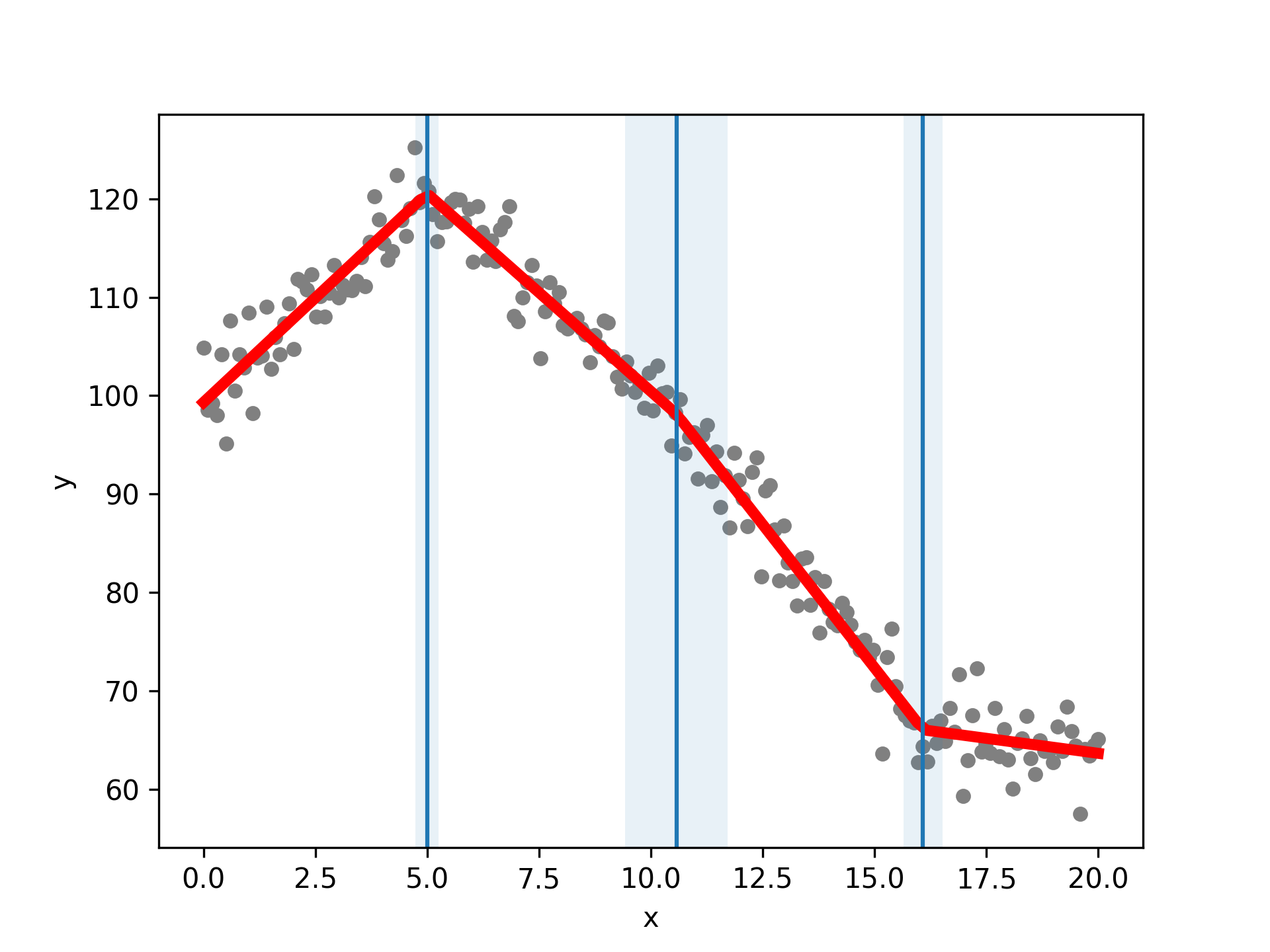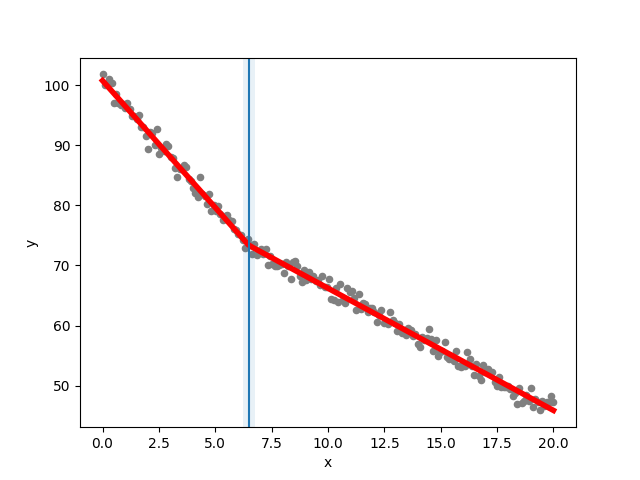piecewise (segmented) regression in python
Project description
Easy to use piecewise regression (aka segmented regression) in Python. For fitting straight lines to data where there is one or more changes in gradient (known as breakpoints). Based on Muggeo “Estimating regression models with unknown break-points” (2003). For example:

Installation
You can install piecewise-regression using python’s pip package index
pip install piecewise-regression
The package was developed and tested on Python 3.7.
Getting started
The package requires some x and y data to fit. You also need to specify either a) some initial breakpoint guesses as start_values or b) how many breakpoints you want to fit as n_breakpoints (or both). Here is a very simple example, assuming we already have some data x and y:
import piecewise_regression pw_fit = piecewise_regression.Fit(x, y, n_breakpoints=2) pw_fit.summary()
Example
Here is a more detailed example. We start off generating some data with a breakpoint. This is for demonstration purposes, normally you will have your own data to fit:
import piecewise_regression import numpy as np alpha_1 = -4 alpha_2 = -2 constant = 100 breakpoint_1 = 7 n_points = 200 np.random.seed(0) xx = np.linspace(0, 20, n_points) yy = constant + alpha_1*xx + (alpha_2-alpha_1) * np.maximum(xx - breakpoint_1, 0) + np.random.normal(size=n_points)
Now we fit the model:
# Given some data, fit the model pw_fit = piecewise_regression.Fit(xx, yy, start_values=[5], n_breakpoints=1) # Print a summary of the fit pw_fit.summary()
Example output:
Breakpoint Regression Results
====================================================================================================
No. Observations 200
No. Model Parameters 4
Degrees of Freedom 196
Res. Sum of Squares 193.264
Total Sum of Squares 46201.8
R Squared 0.995817
Adjusted R Squared 0.995731
Converged: True
====================================================================================================
====================================================================================================
Estimate Std Err t P>|t| [0.025 0.975]
----------------------------------------------------------------------------------------------------
const 100.726 0.244 413.63 3.1e-290 100.25 101.21
alpha1 -4.21998 0.0653 -64.605 4.37e-134 -4.3488 -4.0912
beta1 2.18914 0.0689 31.788 - 2.0533 2.325
breakpoint1 6.48706 0.137 - - 6.2168 6.7573
----------------------------------------------------------------------------------------------------
These alphas(gradients of segments) are estimated from betas(change in gradient)
----------------------------------------------------------------------------------------------------
alpha2 -2.03084 0.0218 -93.068 3.66e-164 -2.0739 -1.9878
====================================================================================================
Davies test for existence of at least 1 breakpoint: p=5.13032e-295 (e.g. p<0.05 means reject null hypothesis of no breakpoints at 5% significance)
This includes estimates for all the model variables, along with confidence intervals. The Davies test is a hypothesis test for the existence of at least one breakpoint, against the null hypothesis of no breakpoints.
There are also tools for plotting data:
import matplotlib.pyplot as plt
# Plot the data, fit, breakpoints and confidence intervals
pw_fit.plot_data(color="grey", s=20)
# Pass in standard matplotlib keywords to control any of the plots
pw_fit.plot_fit(color="red", linewidth=4)
pw_fit.plot_breakpoints()
pw_fit.plot_breakpoint_confidence_intervals()
plt.xlabel("x")
plt.ylabel("y")
plt.show()
plt.close()

You can extract data as well:
# Get the key results of the fit pw_results = pw_fit.get_results() pw_estimates = pw_results["estimates"]
How It Works
The package implements Muggeo’s iterative algorithm (Muggeo “Estimating regression models with unknown break-points” (2003)), to quickly find breakpoints. That method simultaneously fits breakpoint positions and the linear models for the different segments of the fit. This method is quick and it gives confidence intervals for all the model estimates. See the accompanying paper for more details.
Muggeo’s method doesn’t always converge on the best solution - sometimes it finds a locally optimal solution or doesn’t converge at all. For this reason the Fit method also implements a process called bootstrap restarting. This involves taking a bootstrap resample of the data, then using this bootstrapped data to try and find a better solution. The number of times this runs can be controlled with n_boot. To run the Fit without bootstrap restarting, set n_boot=0.
If you don’t have good guesses for inital breakpoints, you can just set the number of e.g. n_breakpoints=3. in this case the algorithm will randomly generate starting breakpoints until it finds a solution that converges (up to n_boot times). This is a good option if the algorithm is otherwise not converging.
Model Selection
In addition to the main Fit tool, the package also offers a ModelSelection option based on the Bayesian Information Criterion. This is experimental and not as thorough as the main Fit tool:
ms = piecewise_regression.ModelSelection(x, y, max_breakpoints=6)
This gives the following example output:
Breakpoint Model Comparision Results ==================================================================================================== n_breakpoints BIC converged RSS ---------------------------------------------------------------------------------------------------- 0 421.09 True 1557.4 1 14.342 True 193.26 2 22.825 True 191.23 3 24.169 True 182.59 4 29.374 True 177.73 5 False 6 False Minimum BIC (Bayesian Information Criterion) suggests the best model
Testing
The package includes comprehensive tests.
To run all tests, from the main directory run:
python3 -m "nose"
Note: This requires nosetests, can be downloaded from apt with:
sudo apt install python3-nose
There are also a series of simulation tests that check the estimates have realistic confidence intervals, and the Davies test gives realistic p-values. These can be found in the folder “tests”.
Documentation
Project details
Release history Release notifications | RSS feed
Download files
Download the file for your platform. If you're not sure which to choose, learn more about installing packages.
Source Distribution
Built Distribution
Hashes for piecewise-regression-1.0.3.tar.gz
| Algorithm | Hash digest | |
|---|---|---|
| SHA256 | d64e8406459673a55b9a01aa77270fc7b95fdddf409822608a3fe685ad69cb50 |
|
| MD5 | 1a2d1e9d94b70baf6cb7e6fd8e6266dc |
|
| BLAKE2b-256 | 7a28dd4c05ddd2094144d821e8638d3db46c2f8d8ce63276f750c3b6a2ffe388 |
Hashes for piecewise_regression-1.0.3-py2-none-any.whl
| Algorithm | Hash digest | |
|---|---|---|
| SHA256 | 97b69e887b65743fcef5f4fea7e6b8777fe476c709aac08951503ffc493694f5 |
|
| MD5 | d6306989da0873297497dda6a2642b23 |
|
| BLAKE2b-256 | a0c4aa7e94f51ad38be91042a39f6cecec6ed57243c297c525ca926809d96101 |











